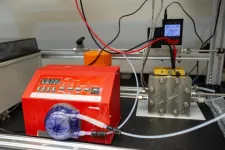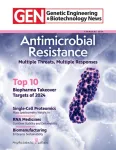(Press-News.org) Engineers at the University of Cincinnati created a more efficient way of converting carbon dioxide into valuable products while simultaneously addressing climate change.
In his chemical engineering lab in UC’s College of Engineering and Applied Science, Associate Professor Jingjie Wu and his team found that a modified copper catalyst improves the electrochemical conversion of carbon dioxide into ethylene, the key ingredient in plastic and a myriad of other uses.
Ethylene has been called “the world’s most important chemical.” It is certainly among the most commonly produced chemicals, used in everything from textiles to antifreeze to vinyl. The chemical industry generated 225 million metric tons of ethylene in 2022.
Wu said the process holds promise for one day producing ethylene through green energy instead of fossil fuels. It has the added benefit of removing carbon from the atmosphere.
“Ethylene is a pivotal platform chemical globally, but the conventional steam-cracking process for its production emits substantial carbon dioxide,” Wu said. “By utilizing carbon dioxide as a feedstock rather than depending on fossil fuels, we can effectively recycle carbon dioxide.”
The study was published in the journal Nature Chemical Engineering.
Wu’s students, including lead author and UC graduate Zhengyuan Li, collaborated with Rice University, Oak Ridge National Laboratory, Brookhaven National Laboratory, Stony Brook University and Arizona State University. Li received a prestigious graduate student award last year from the College of Engineering and Applied Science.
The electrocatalytic conversion of carbon dioxide produces two primary carbon products, ethylene and ethanol. Researchers found that using a modified copper catalyst produced more ethylene.
“Our research offers essential insights into the divergence between ethylene and ethanol during electrochemical CO2 reduction and proposes a viable approach to directing selectivity toward ethylene,” lead author Li said.
“This leads to an impressive 50% increase in ethylene selectivity,” Wu said. “Ideally, the goal is to produce a single product rather than multiple ones.”
Sponsored by the U.S. Department of Energy’s Office of Energy Efficiency and Renewable Energy. Its Industrial Efficiency and Decarbonization Office is leading efforts to reduce fossil fuels and carbon emissions in industry wherever possible.
Li said the next step is refining the process to make it more commercially viable. The conversion system loses efficiency as byproducts of the reaction such as potassium hydroxide begin forming on the copper catalyst.
“The electrode stability must be improved for commercial deployment. Our next focus is to enhance stability and extend its operation from 1,000 to 100,000 hours,” Li said.
Wu said these new technologies will help make the chemical industry greener and more energy efficient.
“The overarching objective is to decarbonize chemical production by utilizing renewable electricity and sustainable feedstock,” Wu said. “Electrifying the conversion of carbon dioxide to ethylene marks a significant stride in decarbonizing the chemical sector.”
END
Conversion process turns greenhouse gas into ethylene
Efficient process holds promise for greener chemical production
2024-02-09
ELSE PRESS RELEASES FROM THIS DATE:
Predicting psychosis before it occurs
2024-02-09
The onset of psychosis can be predicted before it occurs, using a machine-learning tool which can classify MRI brain scans into those who are healthy and those at risk of a psychotic episode. An international consortium including researchers from the University of Tokyo, used the classifier to compare scans from over 2,000 people from 21 global locations. About half of the participants had been identified as being clinically at high risk of developing psychosis. Using training data, the classifier was 85% accurate at differentiating between people ...
New research shows students' knowledge and perceptions of active learning declined during pandemic-era teaching
2024-02-09
Students’ knowledge and perceptions of active learning declined significantly during COVID-induced remote teaching and have not recovered to pre-pandemic levels, according to new research from Chapman University Assistant Professor Jeremy Hsu.
Hsu says the benefits of active learning – exercises like group projects, problem-solving and class discussions – are well documented, but he emphasizes that students’ understanding and perceptions of the practice can affect their level of engagement and investment. If students have limited exposure or are hesitant to participate in active learning practices, resistance could ...
Evaluating the performance of AI-based large language models in radiation oncology
2024-02-09
A new study evaluates an artificial intelligence (AI)-based algorithm for autocontouring prior to radiotherapy in head and neck cancer. Manual contouring to pinpoint the area of treatment requires significant time, and an AI algorithm to enable autocontouring has been introduced. The study is published in the peer-reviewed journal AI in Precision Oncology. Click here to read the article now.
Nikhil Thaker, from Capital Health and Bayta Systems, and coauthors, evaluated the performance of various LLMs, including OpenAI’s GPT-3.5-turbo, GPT-4, GPT-4-turbo, ...
Sandia awarded for outstanding work in technology transfer
2024-02-09
ALBUQUERQUE, N.M. — One of Sandia National Laboratories’ core missions is to help the world through innovation.
However, transferring some of that innovation from the Labs to industry isn’t always an easy process.
Through hard work and ingenuity, some Sandia employees are excelling at moving technology to market, a feat that is now being honored by the Federal Laboratory Consortium. The consortium, composed of more than 300 members nationwide, provides a forum to develop strategies and opportunities for linking laboratory technologies and expertise in the marketplace.
Regional Technology Transfer Award: Disinfectant ...
Evaluating AI-based nodal contouring in head and neck cancer
2024-02-09
A new study evaluates an artificial intelligence (AI)-based algorithm for autocontouring prior to radiotherapy in head and neck cancer. Manual contouring to pinpoint the area of treatment requires significant time, and an AI algorithm to enable autocontouring has been introduced. The study is published in the peer-reviewed journal AI in Precision Oncology. Click here to read the article now.
Sushil Beriwal, from Allegheny Health Network, and Varian, and coauthors, analyzed 108 patients ...
The Lancet: Black women in the USA were murdered six times more often than White women between 1999 and 2020, state-level analysis indicates
2024-02-09
Analysis of racial disparities in US homicide rates indicates Black women were on average six times more likely to die by homicide than White women between 1999 and 2020.
Homicide rates among Black women were significantly higher than for White women in all 30 states analysed, with some evidence suggesting the biggest differences are in states with the highest racial inequities.
The greatest disparity in homicide rates was in Wisconsin in 2019-2020, when Black women were 20 times more likely to be ...
Study shows clinical benefit of new way of treating advanced ER+ breast cancer
2024-02-09
A research paper published today (8 February 2024) in The Lancet Oncology demonstrates that the drug enobosarm, a selective androgen receptor modulator which stimulates the male sex hormone receptor has anti-tumour effects in oestrogen receptor positive breast cancer patients.
Lead author Professor Carlo Palmieri from the University of Liverpool and The Clatterbridge Cancer Centre NHS Foundation Trust, said: “These results are very encouraging – we have shown that in advanced/metastatic breast cancer ...
Repeat testing for pre-eclampsia does not lead to better outcomes for pregnant women, but a single test is still beneficial
2024-02-09
A single test to speed up diagnosis of a serious disease in pregnant women does not need to be repeated, new research has found.
Results from the PARROT-2 trial, published today in the Lancet by researchers from King’s College London and funded by Jon Moulton Charitable Trust, Tommy’s Charity and the National Institute for Health and Care Research, has ruled out the need for routine repeat placental growth factor-based testing (PIGF) for all women with suspected pre-eclampsia.
PARROT-2 is a large, multi-centre UK trial in 1,252 women ...
Industrial pollution leaves its mark in Mediterranean corals
2024-02-09
UCL Press Release
Under embargo until Friday 9 February, 00:01 UK time
Industrial pollution leaves its mark in Mediterranean corals
For the first time, pollutants from burning fossil fuels have been found embedded in corals, offering scientists a potential new tool to track the history of pollution, finds a new study led by UCL researchers.
The study, published in the journal Science of the Total Environment, identified carbon particles emitted by burning fossil fuels embedded in the corals of Illa Grossa Bay, off the Columbretes Islands in the Mediterranean Sea. Finding this type of pollution – known as fly-ash or spheroidal carbonaceous particles (SCPs) ...
Urgent call for antitrust measures to safeguard innovation in spatial biology
2024-02-09
Recent breakthroughs in spatial biology technology have transformed biomedical research; however, legal disputes are preventing small, innovative companies from advancing new technologies and ideas. Ongoing litigation poses a threat to the progress of even the most promising scientific technologies and the potential discoveries they could enable, according to the authors of the exclusive article titled “Sounding an Alarm Over Spatial Biology,” in Genetic Engineering and Biotechnology News (GEN). Click here to read the article ...
LAST 30 PRESS RELEASES:
Air pollution exposure and birth weight
Obstructive sleep apnea risk and mental health conditions among older adults
How talking slows eye movements behind the wheel
The Ceramic Society of Japan’s Oxoate Ceramics Research Association launches new international book project
Heart-brain connection: international study reveals the role of the vagus nerve in keeping the heart young
Researchers identify Rb1 as a predictive biomarker for a new therapeutic strategy in some breast cancers
Survey reveals ethical gaps slowing AI adoption in pediatric surgery
Stimulant ADHD medications work differently than thought
AI overestimates how smart people are, according to HSE economists
HSE researchers create genome-wide map of quadruplexes
Scientists boost cell "powerhouses" to burn more calories
Automatic label checking: The missing step in making reliable medical AI
Low daily alcohol intake linked to 50% heightened mouth cancer risk in India
American Meteorological Society announces Rick Spinrad as 2026 President-Elect
Biomass-based carbon capture spotlighted in newly released global climate webinar recording
Illuminating invisible nano pollutants: advanced bioimaging tracks the full journey of emerging nanoscale contaminants in living systems
How does age affect recovery from spinal cord injury?
Novel AI tool offers prognosis for patients with head and neck cancer
Fathers’ microplastic exposure tied to their children’s metabolic problems
Research validates laboratory model for studying high-grade serous ovarian cancer
SIR 2026 delivers transformative breakthroughs in minimally invasive medicine to improve patient care
Stem Cell Reports most downloaded papers of 2025 highlight the breadth and impact of stem cell research
Oxford-led study estimates NHS spends around 3% of its primary and secondary care budget on the health impacts of heat and cold in England
A researcher’s long quest leads to a smart composite breakthrough
Urban wild bees act as “microbial sensors” of city health.
New study finds where you live affects recovery after a hip fracture
Forecasting the impact of fully automated vehicle adoption on US road traffic injuries
Alcohol-related hospitalizations from 2016 to 2022
Semaglutide and hospitalizations in patients with obesity and established cardiovascular disease
Researchers ‘listen in’ to embryo-mother interactions during implantation using a culture system replicating the womb lining
[Press-News.org] Conversion process turns greenhouse gas into ethyleneEfficient process holds promise for greener chemical production








